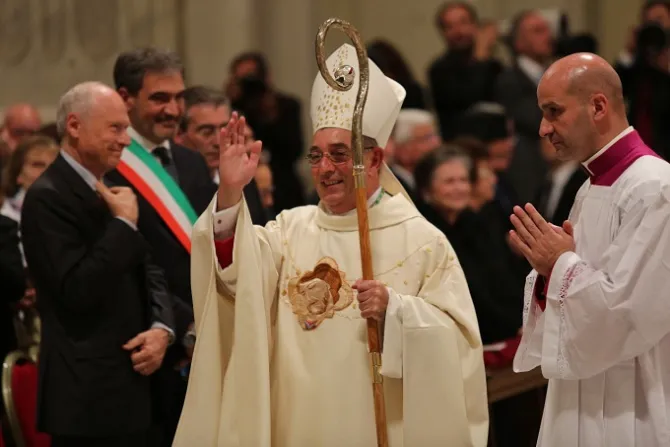Vatican City, May 26, 2017 / 03:32 am
On Friday the Vatican announced that Bishop Angelo de Donatis had been chosen by Pope Francis as the new Vicar of Rome, who will oversee the administrative needs of the Roman diocese, including its clergy.
In addition to naming him Vicar of Rome, Francis also named Donatis an archbishop, according to the May 26 Vatican communique on the announcement.
He will be taking over for Cardinal Agostino Vallini, who has held the position since 2008, under Benedict XVI. Currently also a member of the Council for the Economy established by Pope Francis in 2014, Vallini previously served as Prefect of the Apostolic Signatura from 2004 until his appointment as Vicar of Rome.
Bishop Donatis was born in Casarano, in the Nardo-Gallipoli province of Italy, in 1954 and served as a priest for the diocese until the early 1980s, when he was incardinated as a priest in Rome.
Well known and loved among Romans and expats alike, Donatis was appointed an auxiliary bishop for Rome by Pope Francis in 2015.
While the Pope is the official Bishop of Rome, the Cardinal Vicar is hand-picked by the Pope after consulting with priests, bishops and cardinals who serve in and around Rome, and is charged with the spiritual administration of the diocese.
According to canon law, every Catholic diocese must have at least one or more vicar generals, however, the Vicar of Rome serves more as a "de facto" bishop due to the Pope's heavy workload with his various responsibilities and commitments.
The man who holds the position also serves as the Archpriest for the papal Basilica of St. John Lateran.
A decree instituted by Pope Paul IV in 1558 also holds that the Vicar of Rome must be a cardinal. Since Pope Francis has already named him as an archbishop, it's likely Donatis could be added to the list of 5 prelates who will get a red hat during the June 28 consistory.
There is also a Vicar General for the Vatican City State, who is the Archpriest of St. Peter's Basilica and is charged with looking after the spiritual needs of the small country. This position is currently held by Cardinal Angelo Comastri, who was tapped for the role by Benedict XVI in 2005.
Donatis, after working in various parishes throughout Rome, was in 1990 named Director of the Office of the Clergy for the Diocese of Rome, a position he held until 1996. He was then named as Spiritual Director at the Pontifical Roman Seminary.
Since 2003 he has served as the parish priest for St. Mark the Evangelist parish, located near Rome's famous Piazza Venezia, and was also named the Assistant for the diocese of Rome's National Association for the Family of Clergy.
In 2014 Pope Francis selected Donatis to preach the Lenten spiritual exercises for the Roman Curia during their weeklong retreat in Ariccia. A year later he was named auxiliary bishop.
After the conclusion of their spiritual exercises in 2014, Pope Francis thanked Donatis for accompanying the Curia and for planting "the seed of the Word of God" in their hearts.
"The Lord will seed the rain and that seed will grow and bear fruit," he said, but added, "we must also thank the sower, no? Because you were the sower and you know how to do it!"
Donatis was ordained a bishop by Pope Francis himself, who during the liturgy connected the ordination to the opening of the Jubilee of Mercy, which at the time was still a month away.
(Story continues below)
"At the beginning of the year of Mercy I ask you as a brother to be merciful," Francis said, adding that "the world needs mercy so much. Teach priests and seminarians the path of mercy; with words, but also with your attitude."
"The mercy of the Father which is always placed in the heart, never hurts anyone," he said, adding that "this is what I wish for you: mercy."
Donatis chose as his episcopal motto the phrase: "Nihil Caritate dulcius," meaning "Nothing is sweeter than love."
His coat of arms includes a shield bearing the image of the lion of St. Mark the Evangelist at the top right, named for the parish he has led since 2003, on top of the color red, symbolizing both blood and love.
Below the shield is a pomegranate – the fruit that in the Bible is a symbol of the blood poured out by Christ and the martyrs. The background of the image is silver in reference to the purity and transparency of the Virgin Mary, to whom Donatis entrusted his episcopal ministry.



